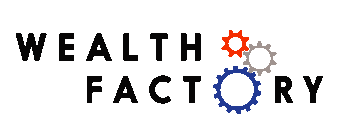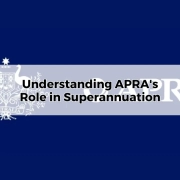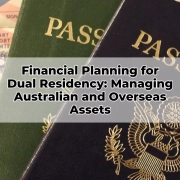Financial Advice in Navigating the Family Home and Super
Table of Contents
ToggleThe family home often holds deep sentimental value. Beyond the emotional significance, however, lies a substantial financial asset—frequently the largest single component of personal wealth in Australia. Its dual role as both a shelter and a store of wealth creates complexity when
planning for retirement or aged care. As life circumstances evolve—such as downsizing, transitioning to aged care, or estate planning—strategic decisions regarding the family home can have significant ramifications. Clear-headed financial advice becomes essential to cut through the sentimentality and address financial viability. Particularly in the context of Centrelink assessments, the principal residence can be exempt from means testing in some circumstances, but not all. This underscores the importance of early planning and a thorough understanding of regulatory nuances.
The Family Home
Centrelink treats the principal residence differently to other assets. For homeowners, the residence is generally exempt from the assets test, but the impact shifts once a person enters aged care or sells the property. Navigating this change is a delicate balance of timing, valuation, and intent. If a homeowner vacates the property permanently, the exemption may lapse after a set period. Additionally, rental income from the former home may count toward the income test.
Without precise financial advice, retirees risk missteps that could reduce pension entitlements or trigger avoidable liabilities. A qualified Toowoomba Financial Adviser can assess how best to retain, rent, or sell the home depending on individual circumstances and financial goals.
Superannuation
Superannuation is central to the Australian retirement funding landscape. However, it is subject to stringent regulations and ongoing legislative evolution. Contribution caps, preservation age, taxation rules, and drawdown requirements all shape how and when super can be accessed.
Misunderstanding any one of these facets could hinder retirement outcomes. For those approaching or in retirement, professional Retirement Financial Advice ensures compliance while also enhancing income efficiency. Advisers also help to determine the ideal balance between account-based pensions and lump sum withdrawals—maximising benefits within allowable thresholds. Especially when super is juxtaposed against other assets like the family home, strategic integration is essential for long-term sustainability.
Downsizing: Strategy or Necessity?
Downsizing is often framed as a lifestyle decision, yet it is equally a financial manoeuvre. Selling the family home and moving into a smaller property can unlock capital, reduce maintenance costs, and simplify day-to-day living. Since 1 July 2018, the Downsizer Contribution Scheme allows eligible Australians over 55 to contribute up to $300,000 into super from the proceeds of their home sale—outside the usual contribution caps. However, this strategy may affect Age Pension eligibility and introduce estate planning complexities. In-depth financial modelling, guided by an Online Financial Adviser or in-person adviser, is essential to determine whether downsizing improves or impairs overall financial standing.
The Pros and Cons of Reverse Mortgages
Reverse mortgages enable homeowners to access equity in their property without needing to sell or vacate. Funds may be taken as a lump sum, income stream, or line of credit. While attractive for those with asset-rich but cash-poor circumstances, reverse mortgages carry risks. Interest compounds over time and may erode inheritance potential. Centrelink implications must also be weighed, as loan proceeds may count toward the assets and income tests. Additionally, strict loan-to-value ratio limits apply, particularly for older borrowers. Financial planners assist in stress-testing the strategy under different longevity and market conditions, ensuring it aligns with long-term needs.
Interplay Between the Family Home and Superannuation in Aged Care Planning
Entering residential aged care often brings the dual challenge of deciding what to do with both the family home and superannuation assets. Each decision affects the other. For example, selling the home may provide liquidity to pay Refundable Accommodation Deposits (RADs), but can also impact Centrelink and aged care means testing. Likewise, drawing funds from super may reduce assessable assets in the short term but limit income later. The balance is intricate. A skilled Toowoomba Financial Adviser navigates the complex interrelation between superannuation products, property assets, and aged care costs—maximising entitlements and preserving capital where possible.
Principal Residence Exemption and Super Withdrawals
The family home typically enjoys a Capital Gains Tax (CGT) exemption under the Principal Residence rule. However, this may not apply fully in all situations—especially where the home is used for business or rental purposes. Partial CGT may be triggered under certain conditions, especially if the exemption period has lapsed. On the superannuation side, withdrawals after age 60 are generally tax-free for most Australians, but tax on death benefits to non-dependants may apply. A structured approach to withdrawals, super splitting, and asset allocation can reduce tax liabilities and enhance after-tax outcomes—an essential element of robust Financial Planning Toowoomba.
Individual vs Joint Ownership Considerations
Ownership structures carry far-reaching financial implications. Whether the home is held jointly or in one partner’s name alone can influence Centrelink assessments, estate planning, and even tax outcomes. Similarly, superannuation balances may be deliberately adjusted between partners using contribution splitting strategies or spouse contributions to optimise Age Pension benefits. This is particularly relevant when one partner is below Age Pension age, allowing for legal income shielding. Ownership restructuring must be executed carefully, as gifting rules and deprivation provisions may be triggered. Advanced financial advice can design ownership structures that optimise benefits while remaining compliant with legislative provisions.
Family Home and Super in the Context of Inheritance
Both the family home and superannuation form integral components of intergenerational wealth transfer. However, they operate under very different legal frameworks. The home is dealt with via the will, while superannuation is held in trust and distributed according to binding death
benefit nominations. Mistakes in either area can lead to disputes, delays, or unintended taxation. The intersection of home ownership, super balances, and beneficiary intentions requires synchronised estate planning. Incorporating enduring powers of attorney, testamentary trusts, and binding nominations ensures a seamless and tax-effective transfer of wealth—especially for blended families or vulnerable beneficiaries.
Staging Decisions for Strategic Outcomes
Timing plays a pivotal role in decision-making around both super and the family home. For example, deferring the sale of the home until after Age Pension eligibility is assessed can safeguard benefits. Similarly, accessing super before versus after age 60 has tax consequences. Making a downsizer contribution prior to triggering a pension phase could affect transfer balance caps. Each timeline carries strategic inflection points. Financial advisers help map out these critical windows, ensuring decisions are sequenced to maximise outcomes. Poor timing can erode wealth or entitlements, while precise timing can yield significant financial advantage.
Navigating Legislative Change and Policy Shifts
Australian financial regulation is in constant flux. Superannuation thresholds, Centrelink rules, taxation legislation, and aged care funding mechanisms are subject to change through annual budgets and legislative reforms. What’s optimal today may be obsolete tomorrow. This necessitates dynamic financial advice, especially when long-term plans hinge on current law. Whether it’s the introduction of a new cap, adjustment to deeming rates, or change in downsizer eligibility, staying informed and agile is crucial. An Online Financial Adviser or local Toowoomba Financial Adviser ensures strategies remain compliant and aligned to current policy, offering clients both security and foresight.
Integrating Super, Property, Income, and Legacy
The optimal approach to retirement and aged care planning does not isolate superannuation from property, nor income from estate considerations. Instead, a holistic strategy integrates all elements—family home, super, cash flow, risk tolerance, and legacy intentions—into one cohesive framework. This approach ensures every decision complements the next. It also allows room for contingencies, including health decline, market volatility, or family dynamics. By synthesising these variables, a well-constructed financial plan delivers confidence, stability, and clarity—cornerstones of effective Retirement Financial Advice. Such comprehensive planning offers peace of mind, knowing each aspect of wealth has been addressed.
Conclusion
Navigating the intricate interplay between the family home and superannuation demands a deliberate, structured, and informed approach. These two assets sit at the heart of Australian retirement strategy—and mismanaging them can lead to unintended consequences. Whether it’s unlocking equity, managing Centrelink implications, or transferring wealth to the next generation, every decision matters. With the guidance of a qualified Toowoomba Financial Adviser or Online Financial Adviser, Australians can make these decisions with confidence, clarity, and control. For those seeking tailored solutions and expert guidance, reaching out for
trusted Retirement Financial Advice ensures your retirement roadmap is both sustainable and strategic.









